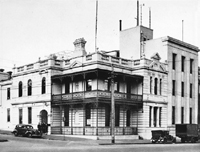


Australian Meteorology through the 20th Century
Introduction
The Origins of Australian Meteorology
Meteorology in the 20th Century
The Forecast for the First Parliament
The Meteorology Act 1906
The Birth of the Bureau
The Early Years
Meteorological Services for Civil Aviation
Meteorology at the Universities
The RAAF Meteorological Service
CSIR Meteorological Physics
The Meteorology Act 1955
Flood Warning
Long-range Forecasting
Antarctica
World Meteorological Centre, Melbourne
Regional Forecasting Centres
Global Weather Experiment
Research in the Bureau
Committees of Inquiry
The Weather and Climate of the Twentieth Century
The Great Weather and Climate Events of the Twentieth Century
A Century of Progress in Science and Service
References
Australian Meteorological Milestones of the 20th Century
Endnotes
Index
Search
Help
Contact us

The Birth of the Bureau
The Bureau of Meteorology formally commenced operation on 1 January 1908 under the first Commonwealth Meteorologist, Henry Hunt, who had been appointed in 1907 ahead of the controversial Queenslander Clement Wragge. The Bureau was housed in the 'Frosterley' building at the corner of Victoria and Drummond Streets, Carlton (Figure 3), a home which was to serve as its national headquarters until it consolidated its by then dispersed Melbourne operations in a new high rise building at 150 Lonsdale Street in 1974.
On 18 January 1908, a full page article in the Melbourne Argus asserted that 'There is probably no other country in the world—not excepting even the United States of America—which is so vitally affected by its varying weather conditions as Australia', and described in detail the working of the new Bureau including the combined role of the Melbourne Office as both a national headquarters and a Divisional Office for Victoria. It noted that each morning the Melbourne Office received a total of 217 reports from across the Commonwealth as the basis for preparation of guidance forecasts for the Divisional Meteorologists in the other capitals. The centrally produced forecasts were initially not well received in distant capitals, and so began the ebb and flow of pressures for greater decentralisation of forecasting which characterised Australian meteorology through most of the twentieth century.
The Early Years
The early years of the Bureau were a period of great scientific progress in the face of a difficult struggle for the funds to pay staff salaries and maintain operations. Henry Hunt, who had worked under H. C. Russell in Sydney, already had a distinguished scientific record and, with the assistance of colleagues Griffith Taylor (later Professor of Geography at Sydney, Chicago and Toronto Universities) and E. T. Quayle, soon published a definitive treatise The Climate and Weather of Australia (Hunt, Taylor and Quayle 1913).By 1919 the permanent staff of the Bureau had grown from an initial Australia-wide complement of 30 (supported by several thousand volunteer observers) to 71. These included two future Directors of the Bureau (W. S. Watt and E. W. Timcke).
The Depression years of the late 1920s and early 30s, with their severe restraint on government spending, were a difficult time for the Bureau. This was exacerbated by the lack of understanding on the part of the Public Service authorities of the need for scientific qualifications for Bureau staff, a problem which was to impair the work of the Bureau for most of the following half century (Gibbs 1982). With the loss of Edward Kidson in 1927 to become Director of the New Zealand Meteorological Office and the retirement of Hunt in 1931, the Bureau lost its scientific leadership and fell into a period of scientific stagnation.
People in Bright Sparcs - Hunt, Henry Ambrose ; Kidson, Edward; Quayle, Edwin Thomas; Russell, Henry Chamberlain; Taylor, Thomas Griffith; Timcke, Edward Waldemar; Watt, William Shand; Wragge, Clement Lindley
 |
Bureau of Meteorology |  |
© Online Edition Australian Science and Technology Heritage Centre and Bureau of Meteorology 2001
Published by Australian Science and Technology Heritage Centre, using the Web Academic Resource Publisher
http://www.austehc.unimelb.edu.au/fam/1601.html